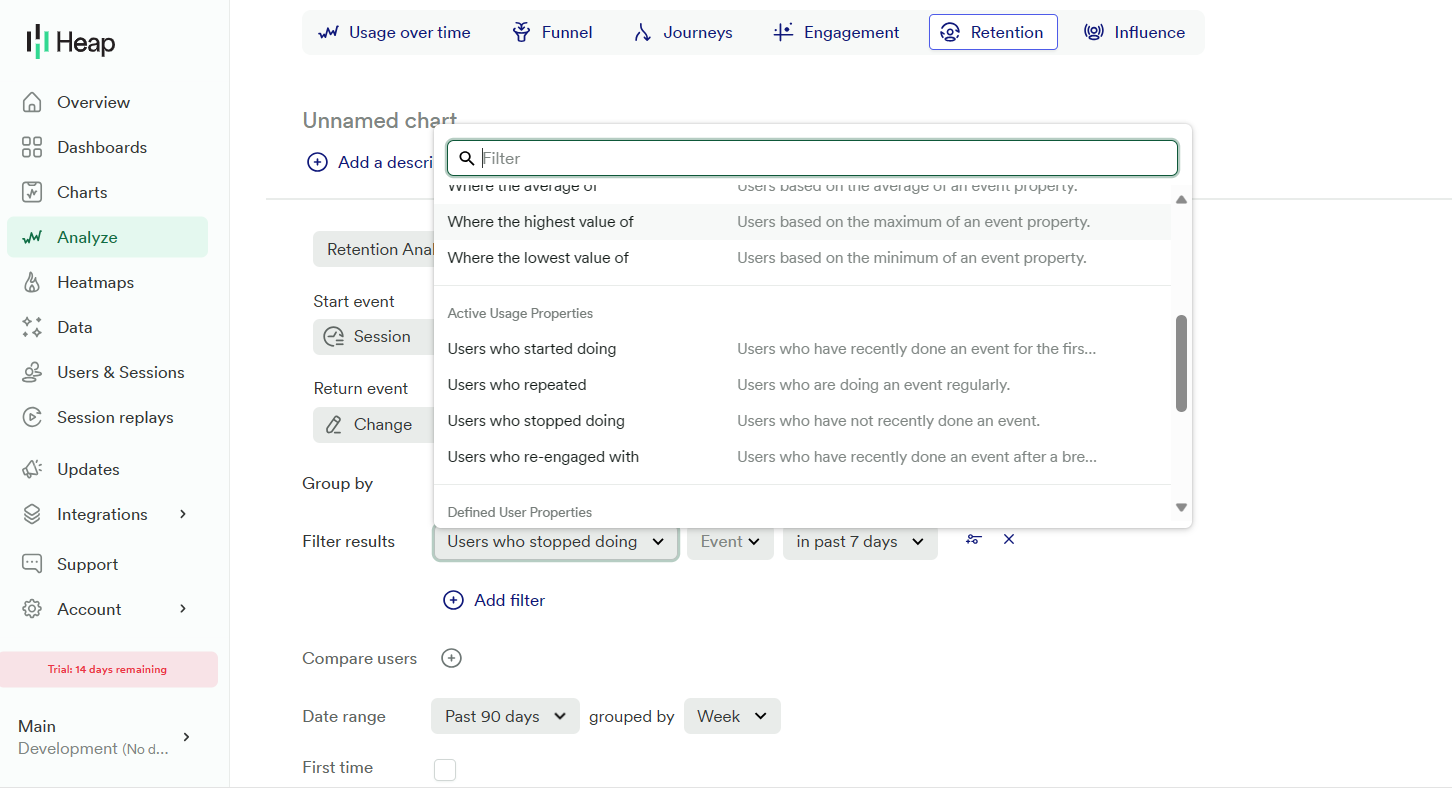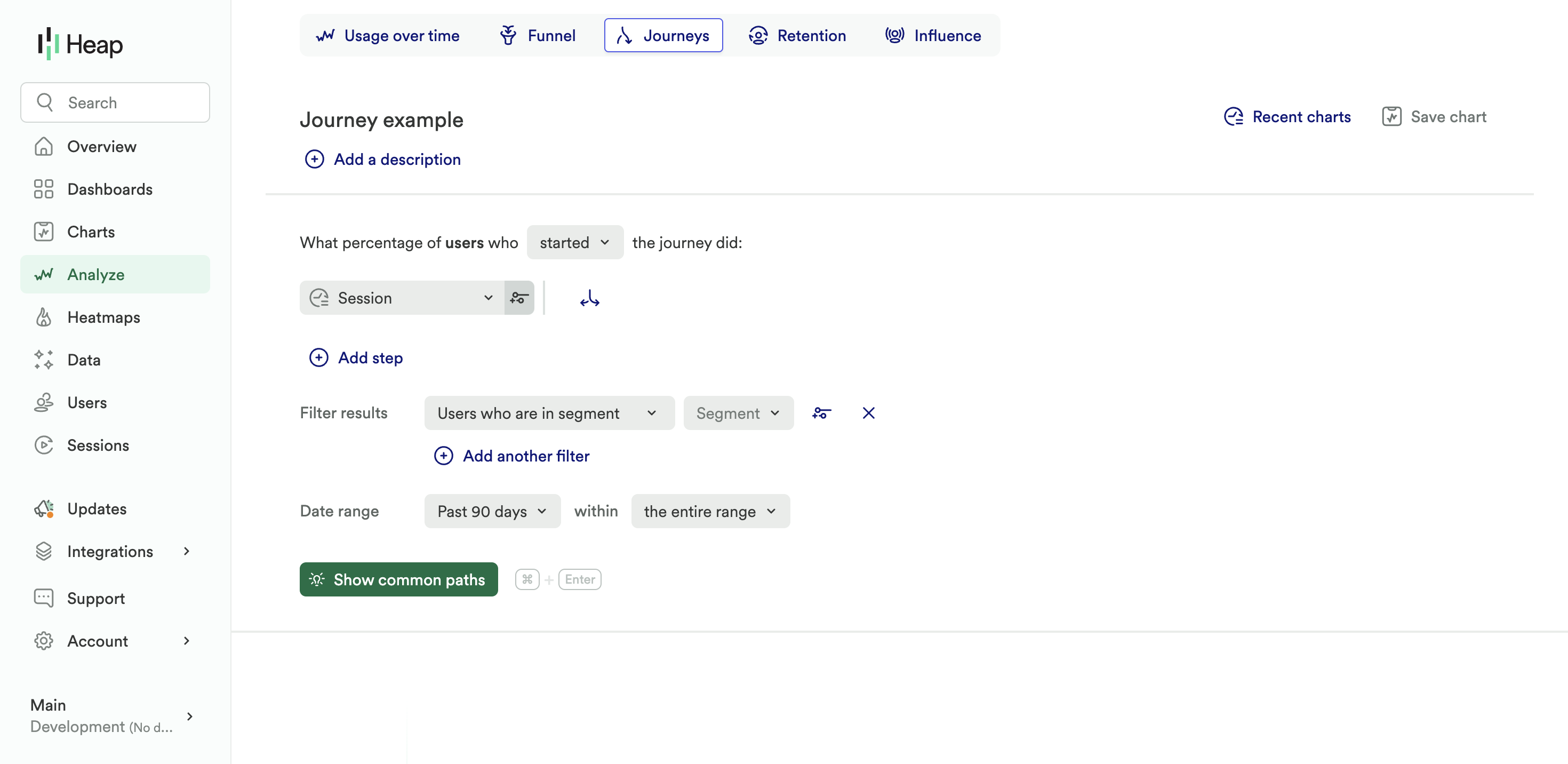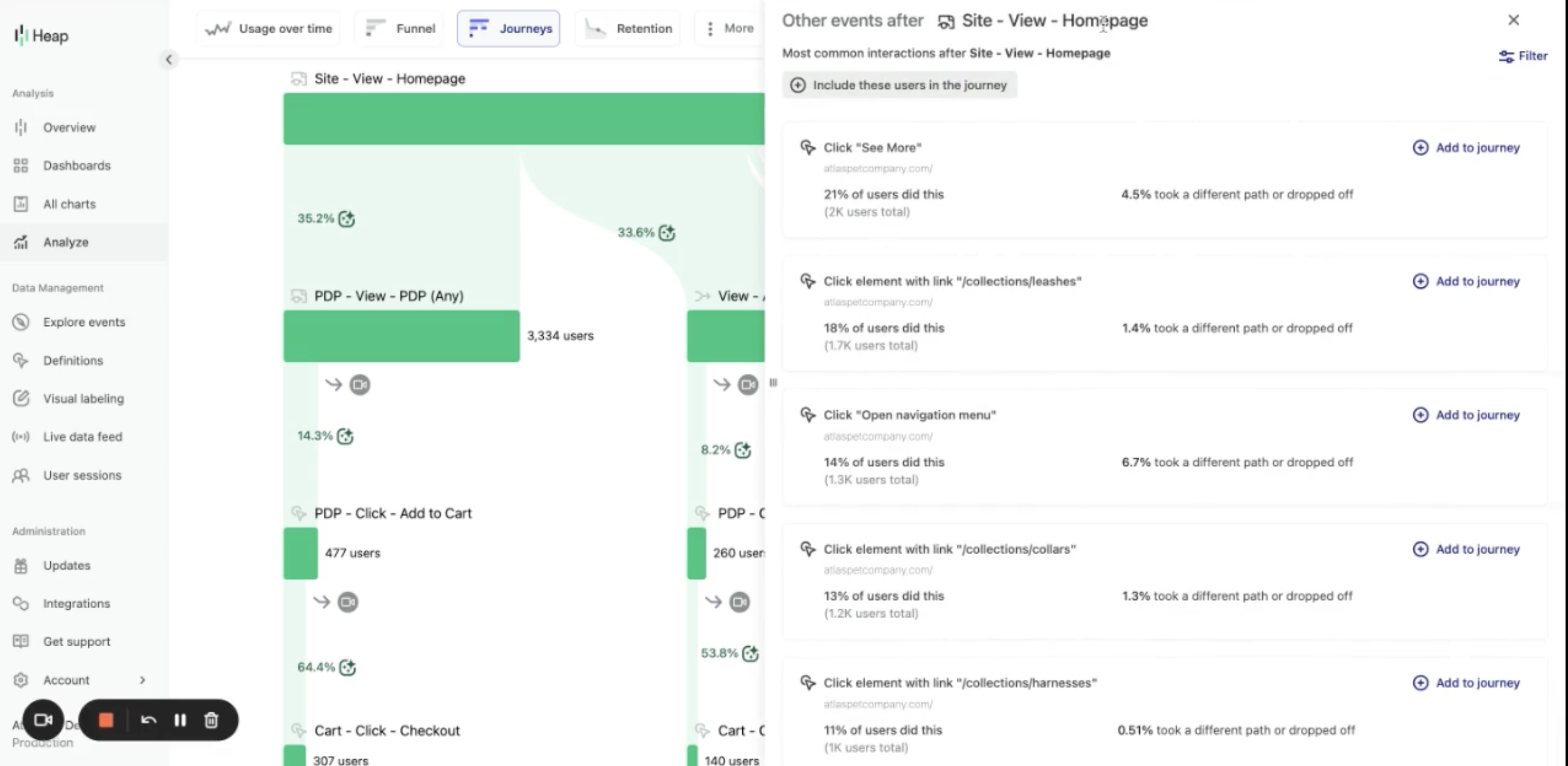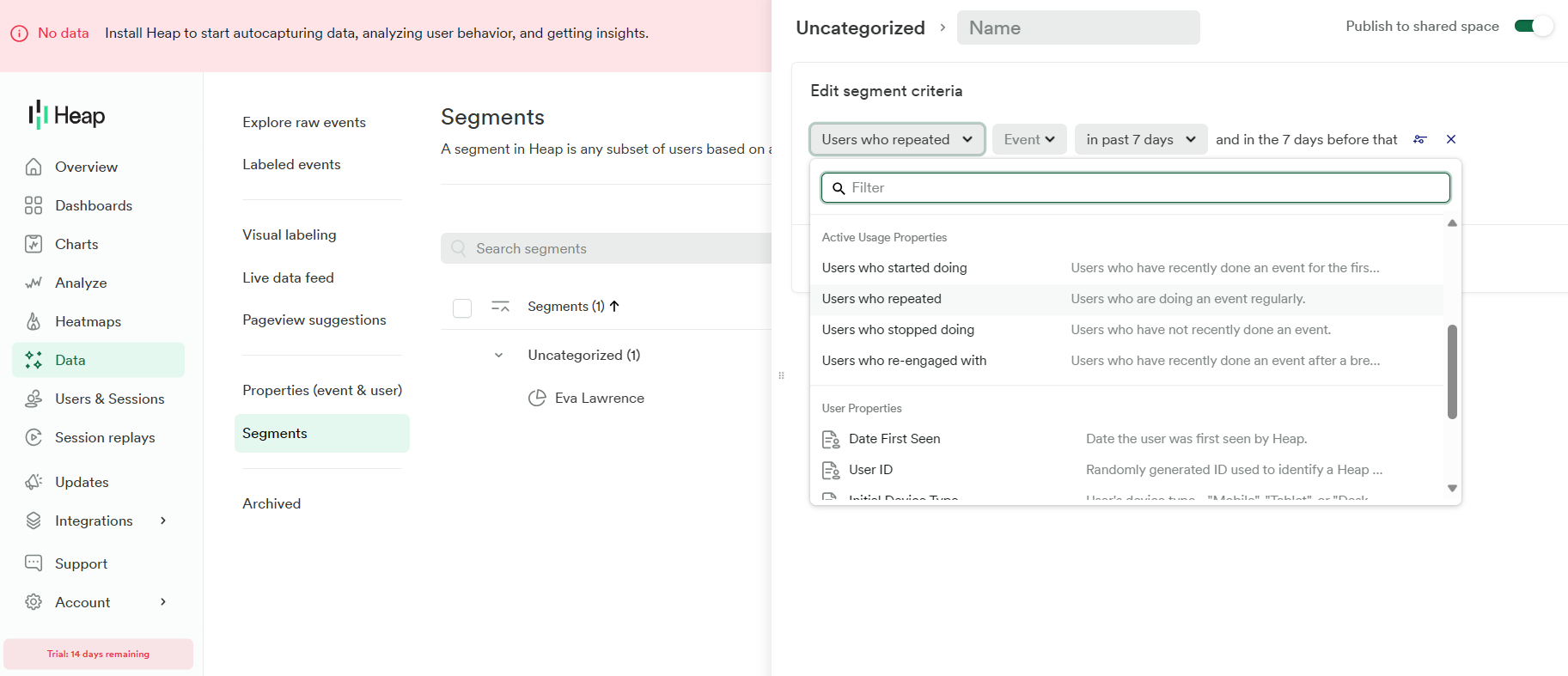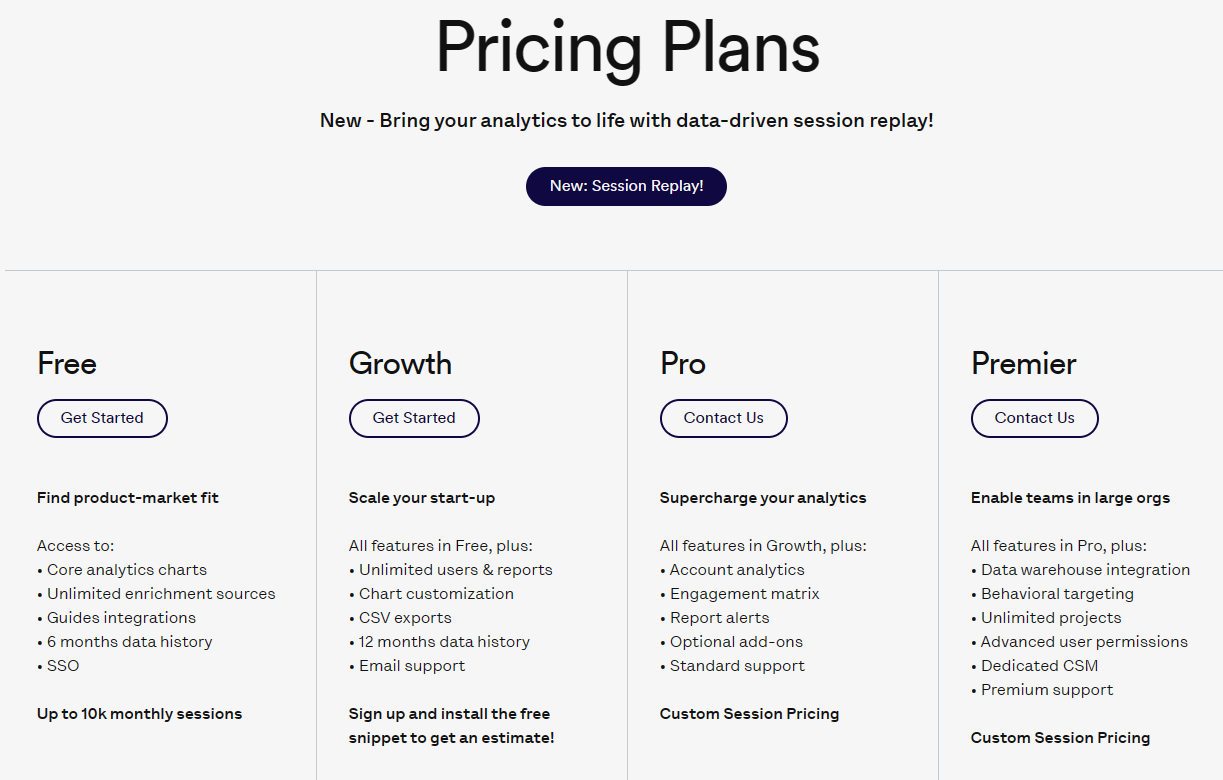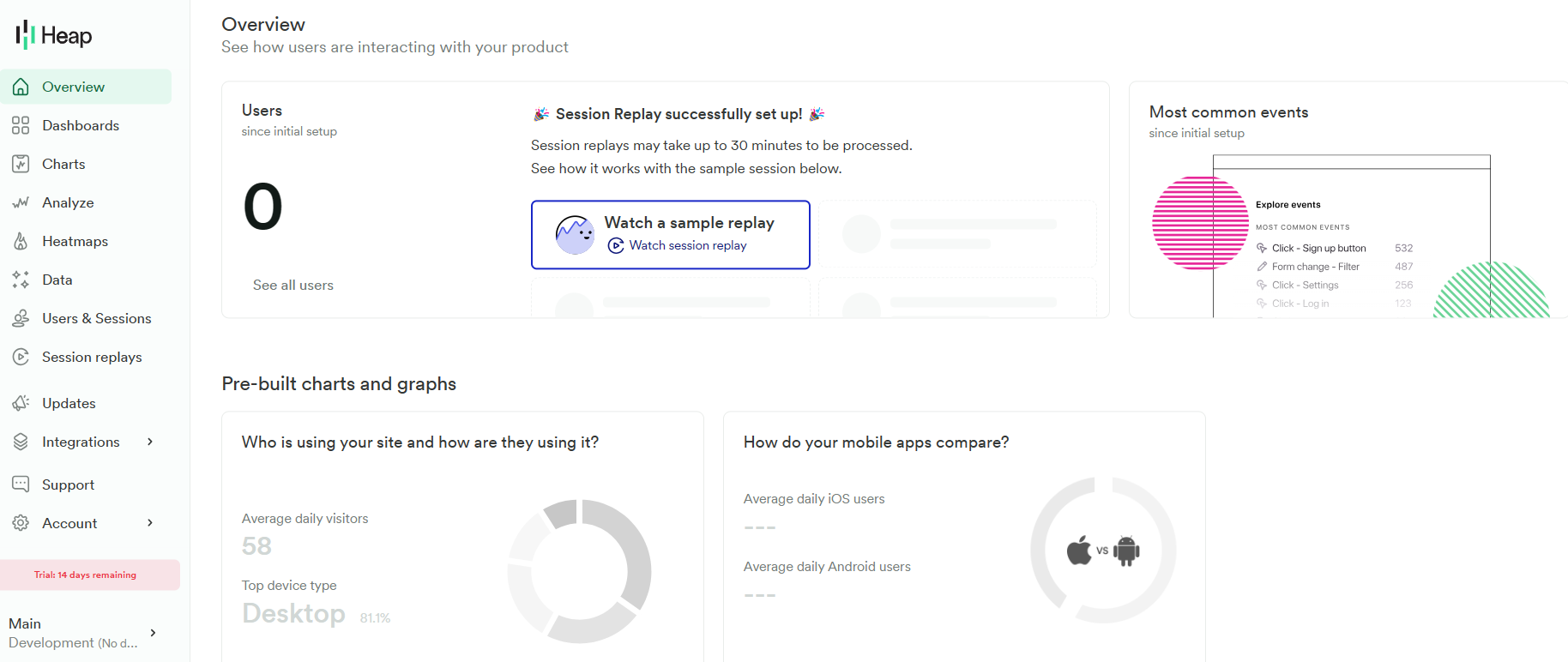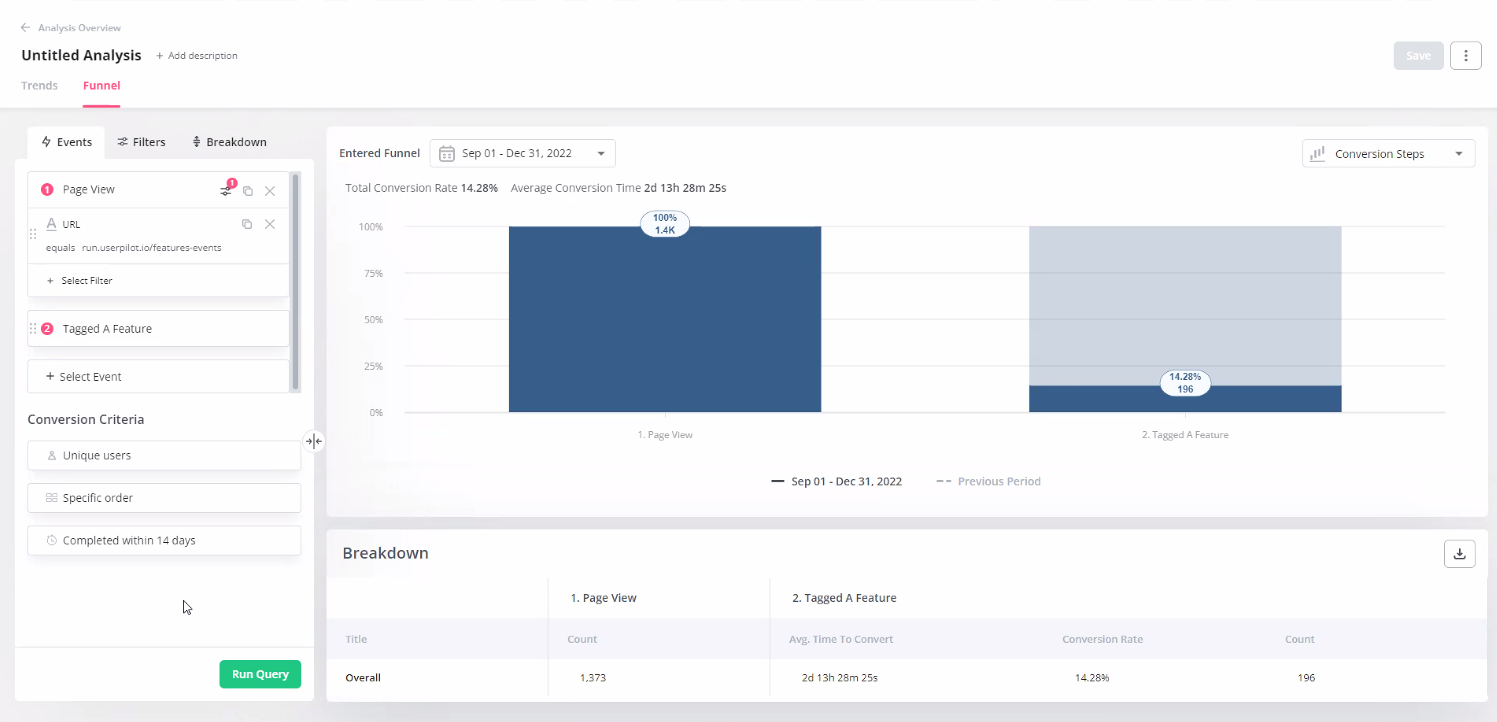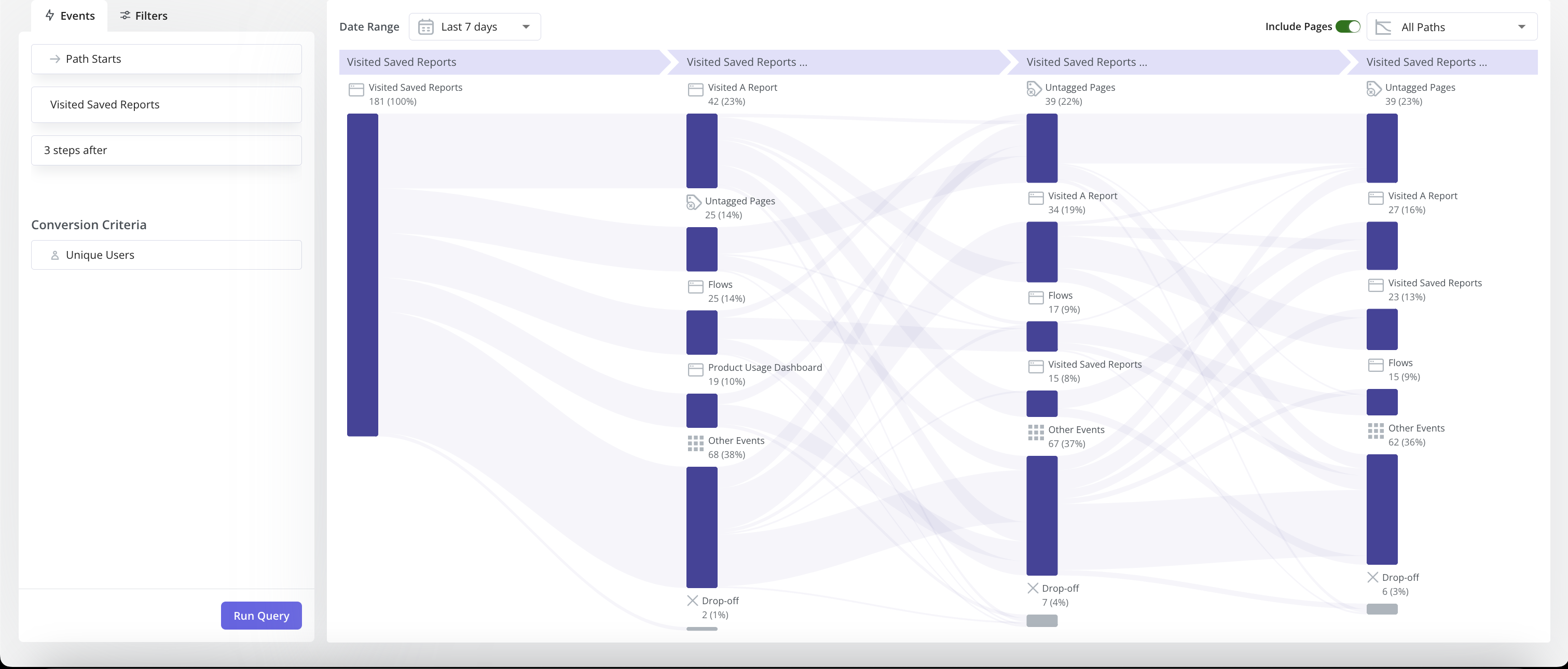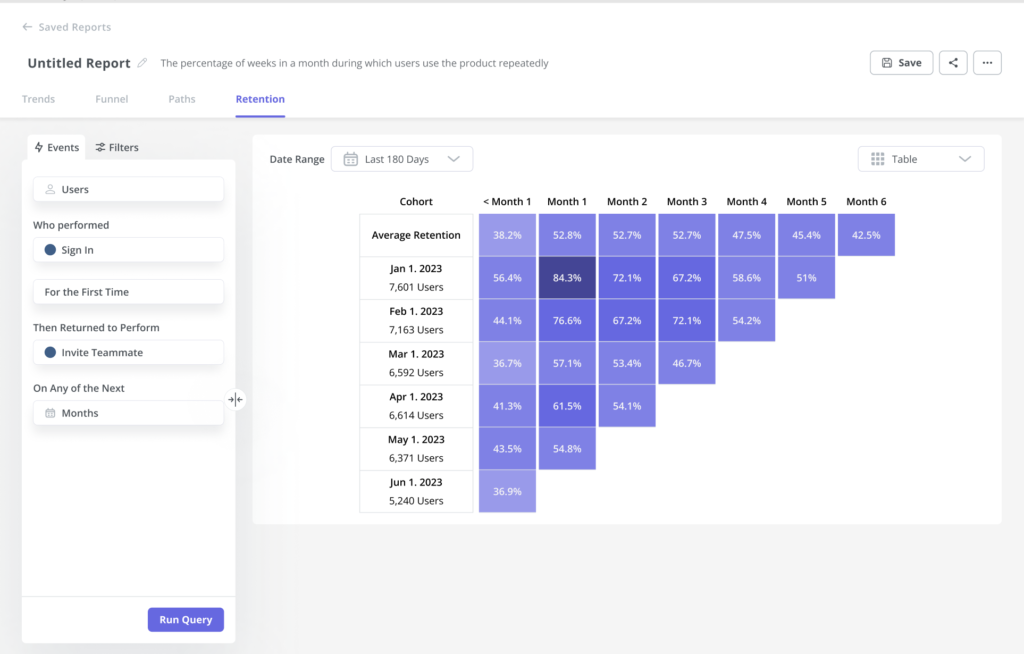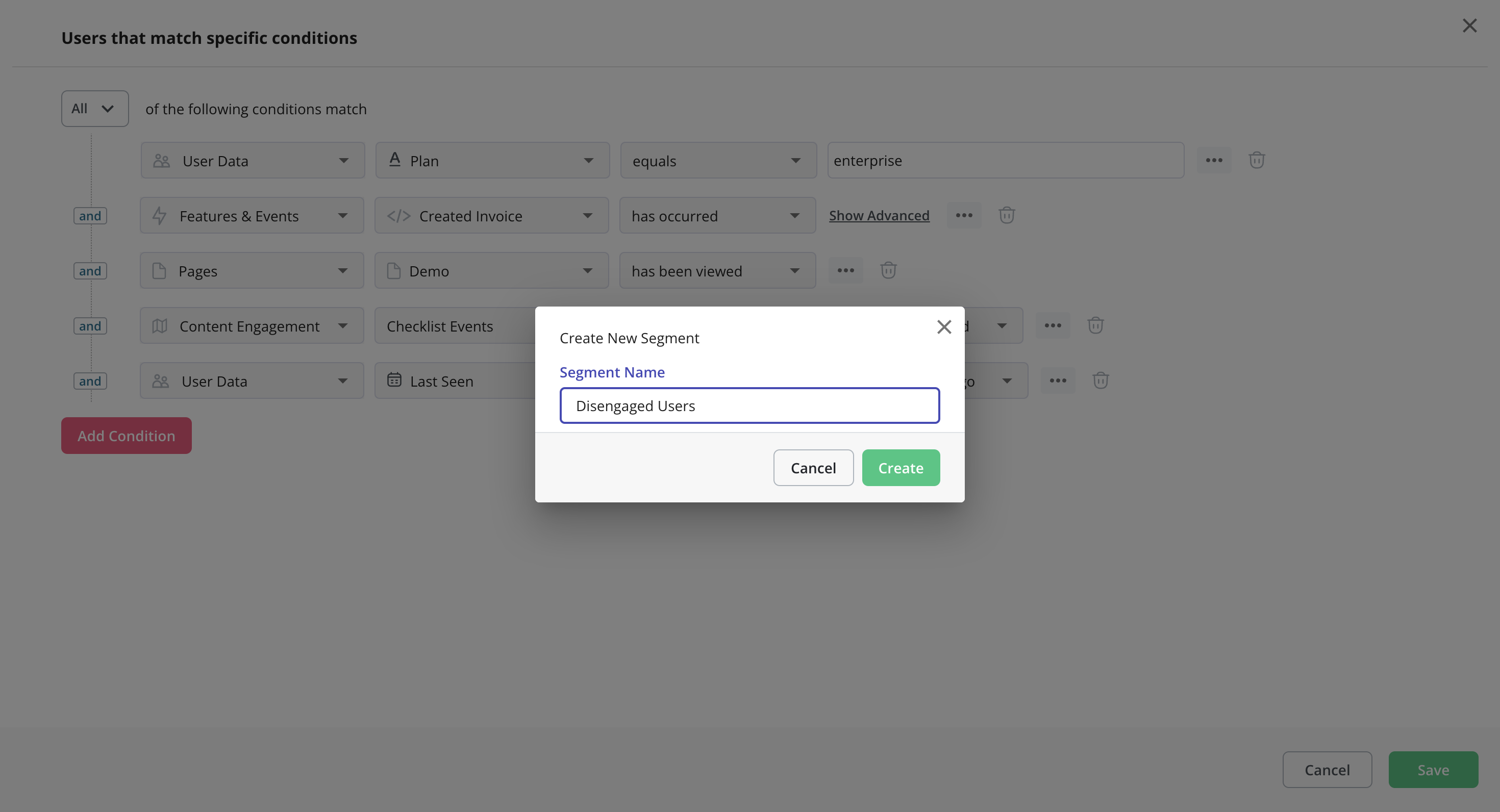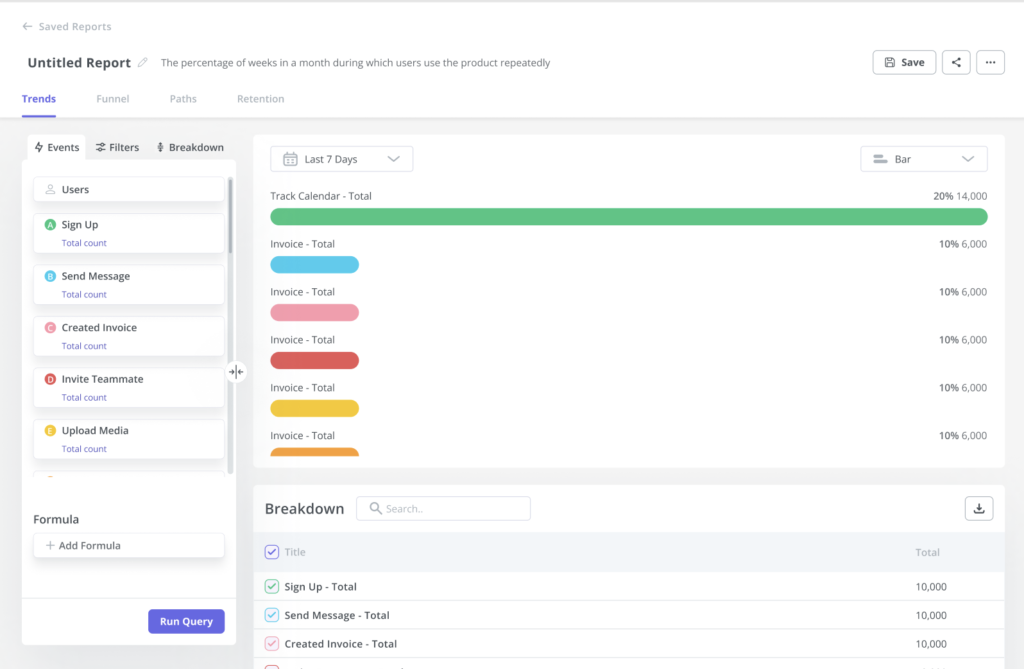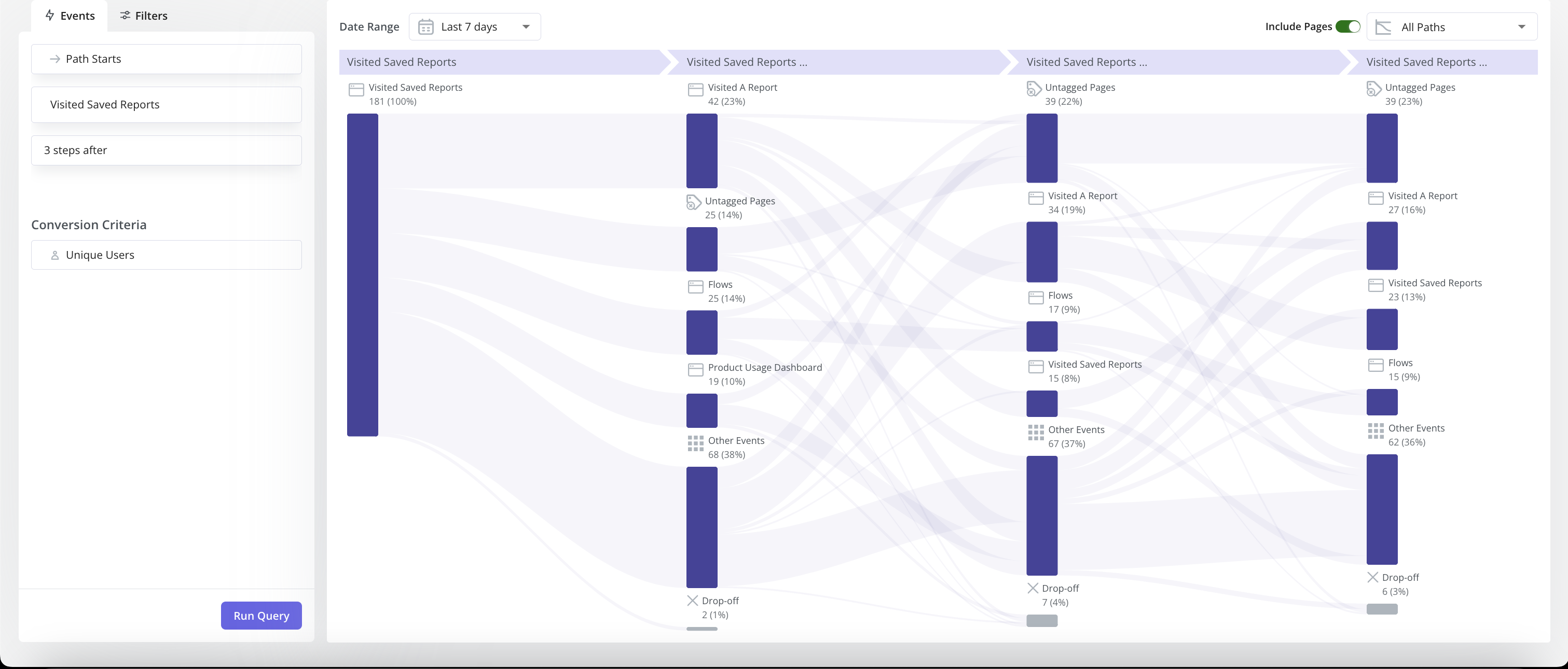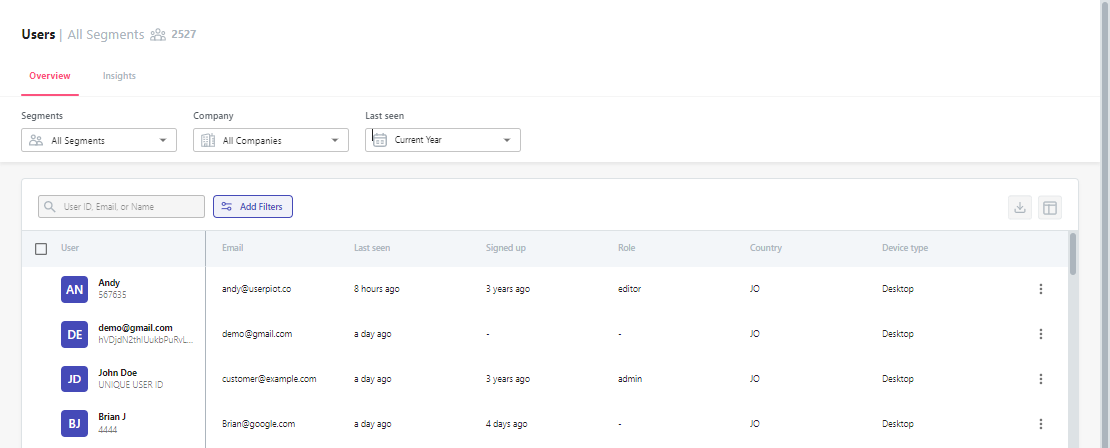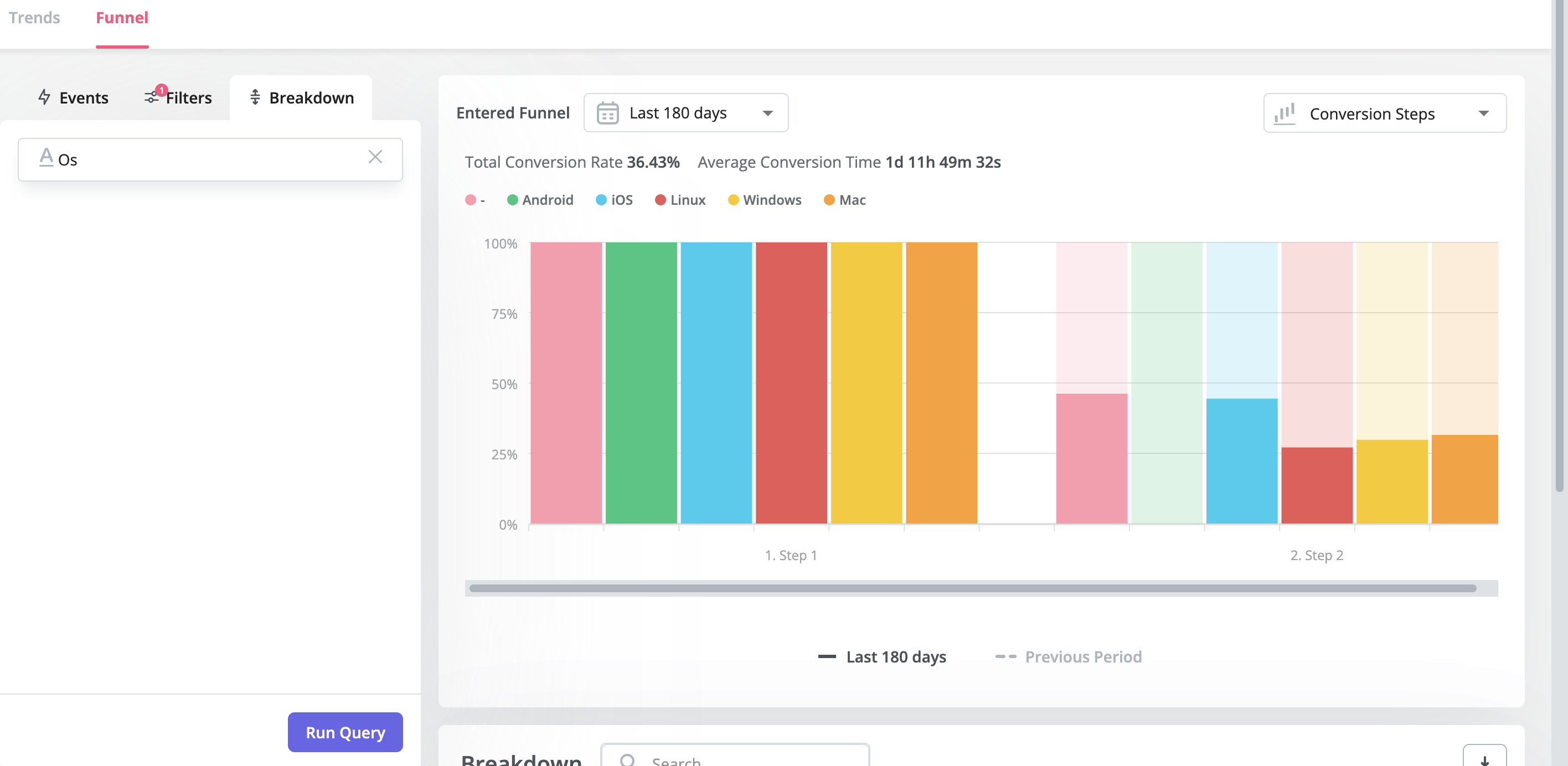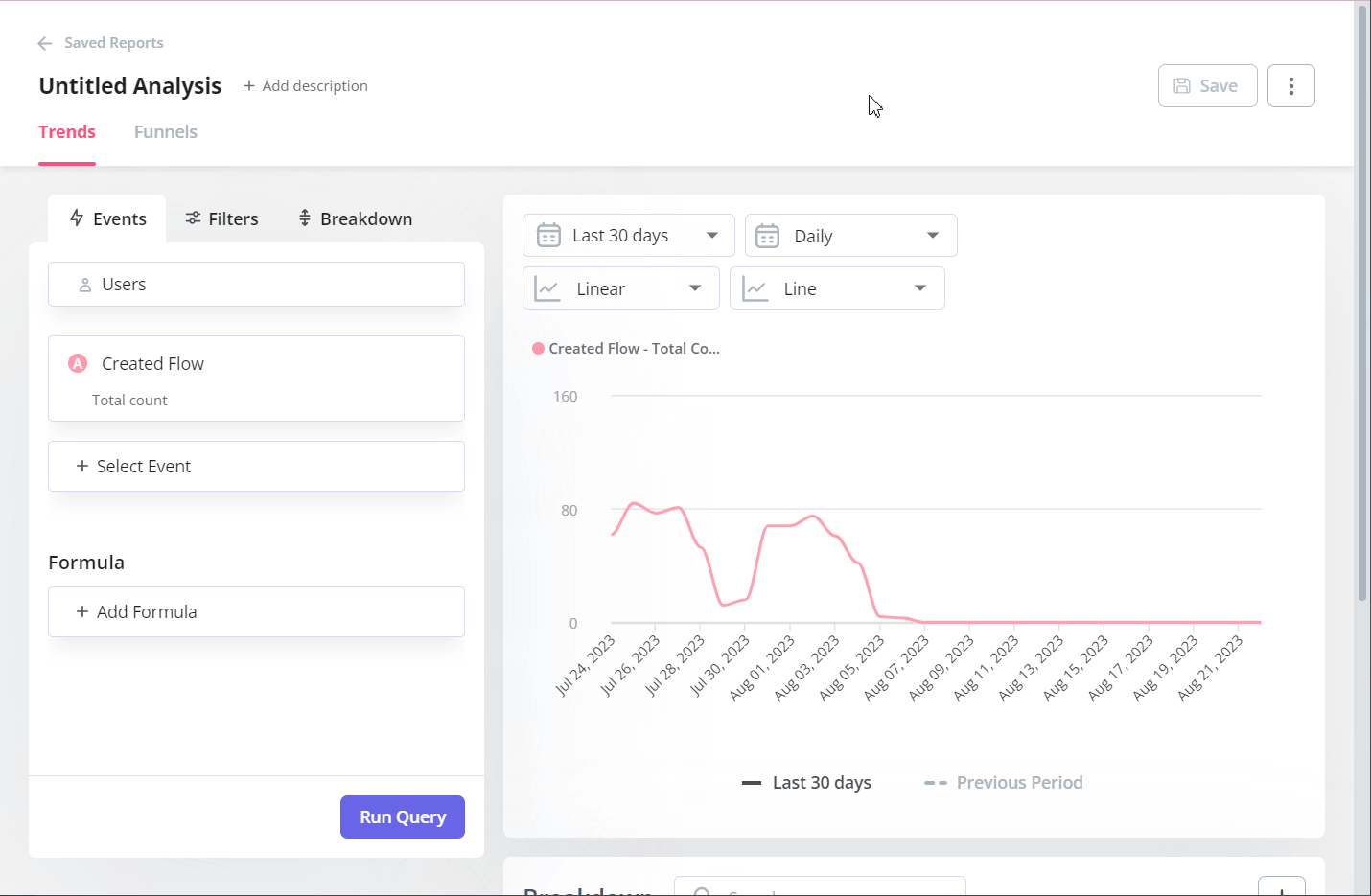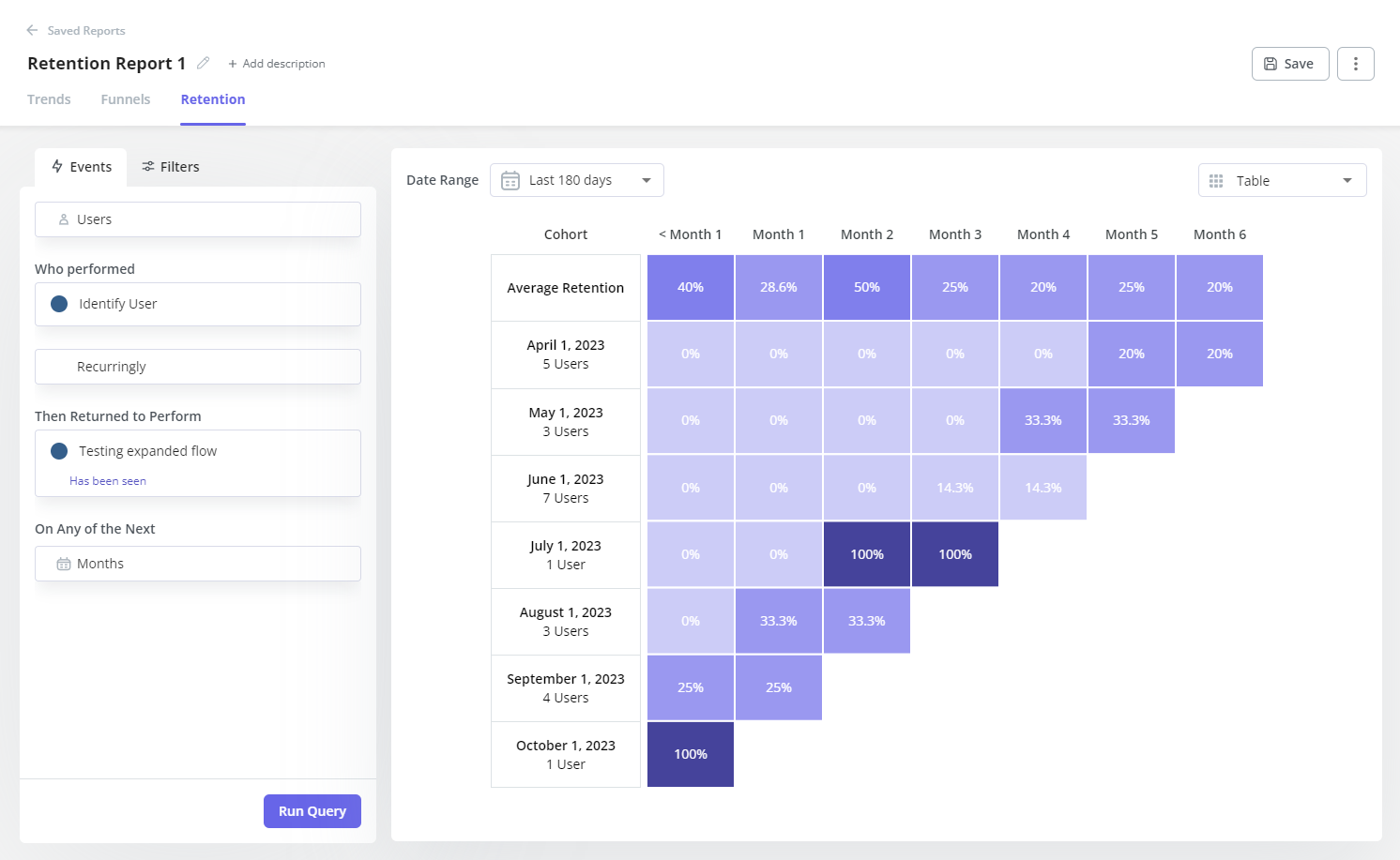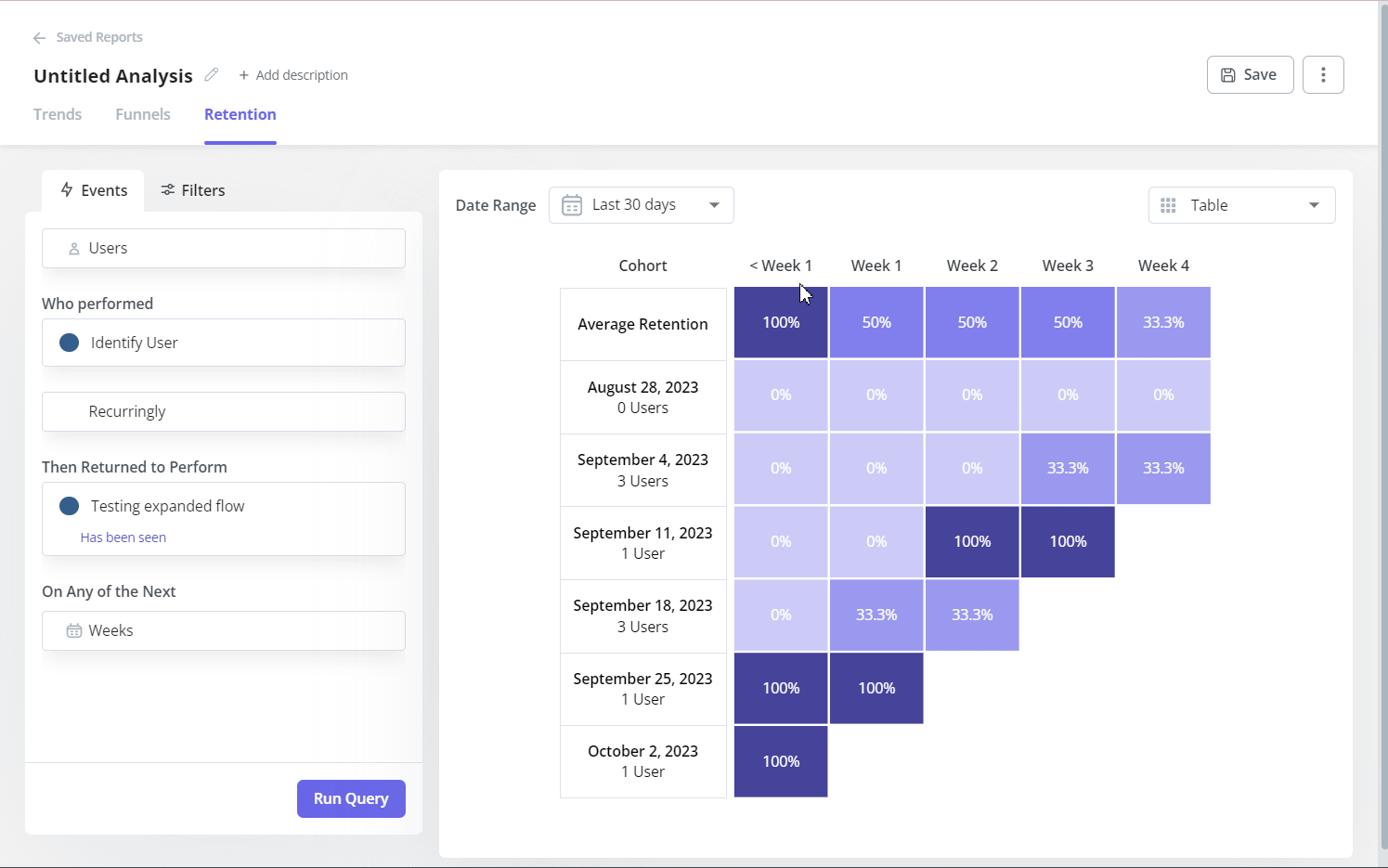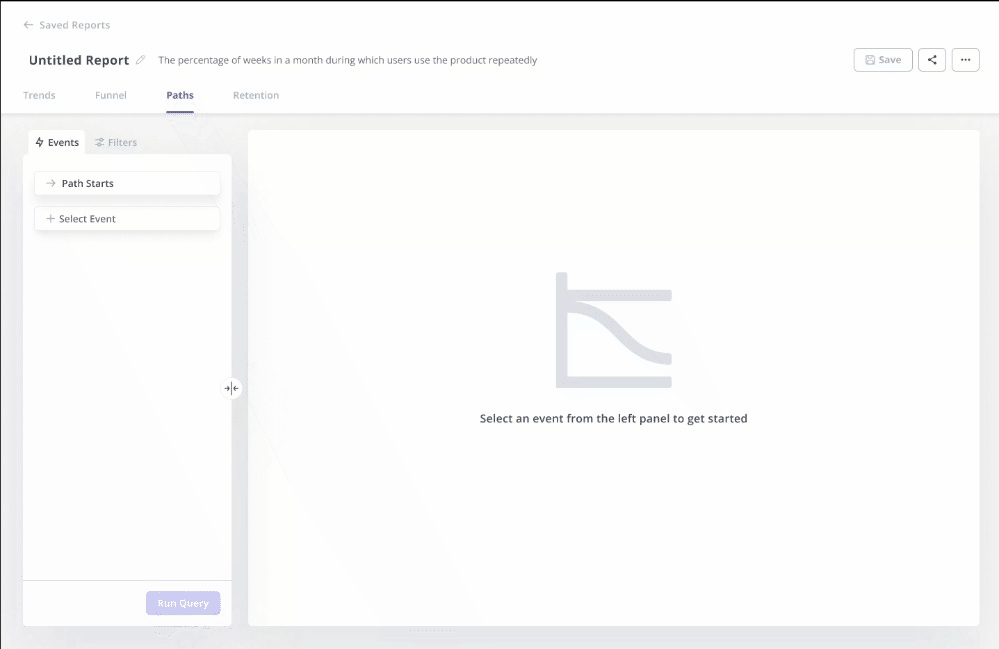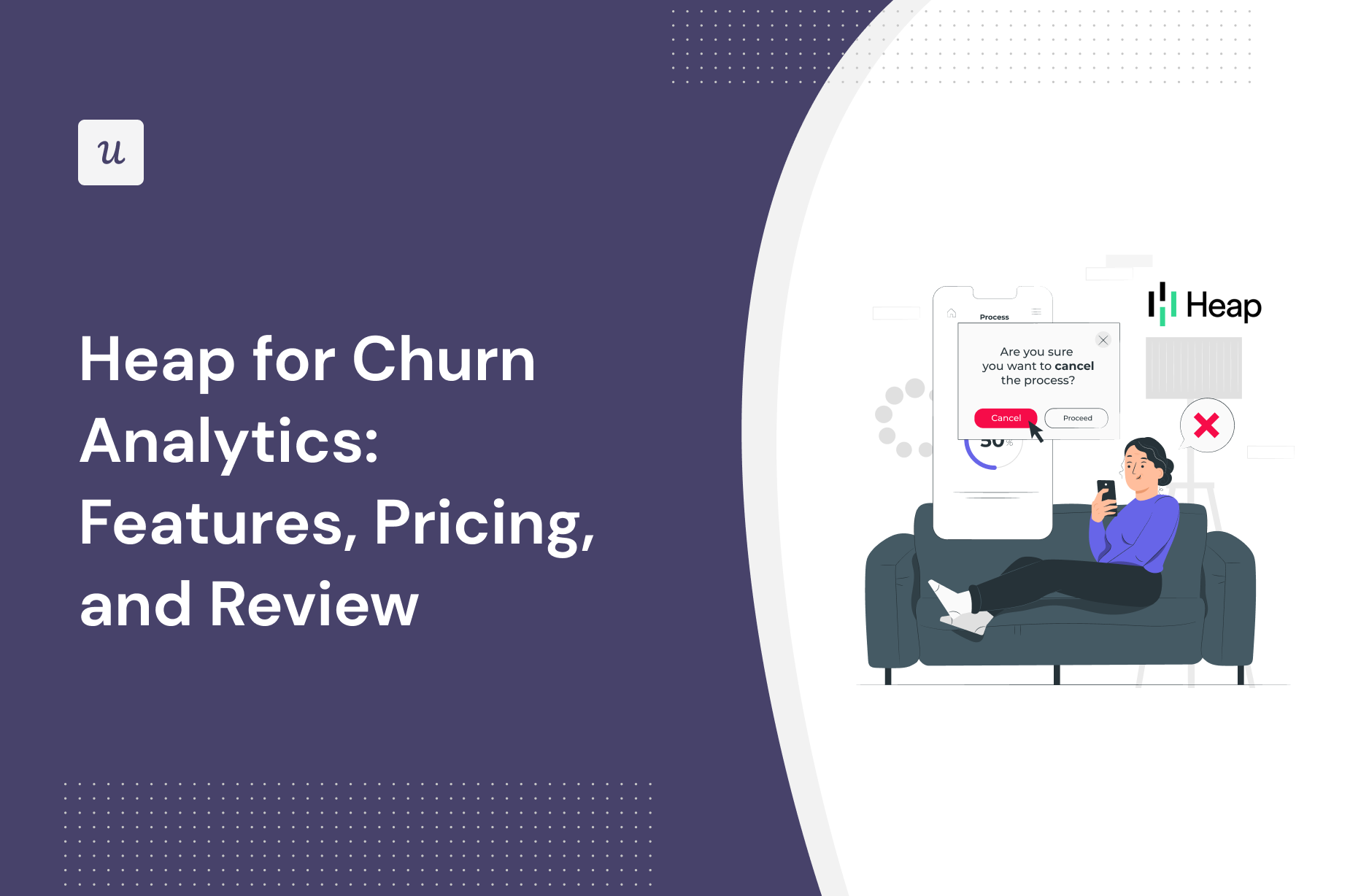
Try Userpilot Now
See Why 1,000+ Teams Choose Userpilot

Heap for churn analytics – quick summary
- Heap is a good choice for churn analytics and it comes with features such as user segmentation analysis, behavioral analytics, user journey mapping, and cohort analysis.
- Heap is one of the most sophisticated product analytics tools available in the market. But it isn’t without flaws. Here are three scenarios where it makes sense to look for a Heap alternative:
- Your team lacks technical know-how – While it’s easy to install and configure Heap, navigating its features requires a bit of technical expertise. If your team members come from non-technical backgrounds, they might struggle to use Heap to the fullest.
- You want to trigger in-app experiences based on analytics – Heap doesn’t offer built-in tools to personalize the user experience based on product analytics and insights. You’ll need to use third-party engagement tools to turn these insights into actions. A product adoption platform like Userpilot can help you bypass the process of finding the right engagement tools.
- You’re on a budget – You need to set up a robust data storage infrastructure to retain all the data and insights collected from Heap. This is in addition to the monthly or annual subscription fee you’ll pay to use Heap. As a result, you’ll likely end up overshooting your budget, which makes Heap unsuitable for small teams and early-stage startups.
- If you’re looking for a better option for churn analytics, Userpilot exceeds both functionality and value for money compared to Heap.
- Ready to see Userpilot in action? Schedule a demo today to explore its powerful churn analytics capabilities firsthand.
What is Heap?
Heap is a robust product analytics platform that provides users with a plethora of in-depth insights into customer behavior and needs. With Heap, you can track user interactions in real time across all touch points within your product.
Insights from Heap help you dig deeper into the paths users take when navigating your product and identify precise points of friction. Plus, the platform uses sophisticated data science capabilities to help you make better-informed, data-driven decisions to improve user experience.
Is Your Heap Churn Analytics Strategy Actionable?
Heap is powerful for identifying where users drop off, but are you acting on that data fast enough to save them? Take this quick assessment to see if you are truly preventing churn.
When Heap churn analytics flags a segment at risk, how do you re-engage them?
How do you currently validate the “why” behind the churn numbers you see in Heap?
Is your team able to fix friction points identified in your churn analysis without code?
Close the Gap Between Analysis and Action
Don’t just watch your users leave. While Heap helps you diagnose the problem, Userpilot helps you fix it. enhance your stack to instantly trigger retention flows based on your analytics.
Must have features of churn analytics tools
Here are some important factors to consider when choosing churn analytics tools:
- Engagement tracking – Customer interactions and usage patterns across various touchpoints to closely monitor user interactions and behaviors to identify areas where customers may be disengaging, allowing you to make appropriate improvements.
- Customer segmentation – So you can segment your customers based on their tendency to churn, behavior, preferences, allowing for personalized outreach and focused initiatives for each group.
- Ability to predict churn risks using different analytics dashboards – Analyzing factors such as usage patterns, engagement levels, customer demographics, and interactions.
- In-app communication – To deliver personalized experiences such as in-app messages, chatbot, live chats, etc., for addressing potential churn.
Heap features for churn analytics
With Heap’s powerful user behavior analytics and product usage insights, performing churn analysis is fairly straightforward. Here’s how you can do it:
- Select Retention Analysis under the Retention chart and select the Start and Return events.
- For churn analysis, you can analyze events like Pageview and Signup. Or you can compare actions like starting a free trial and purchasing a paid plan. You’ll have to label the required events, though.
- Next, you can filter the results using one of the parameters under “Active Usage Properties.” These properties can help you segment the results for different user groups, such as ones who stopped engaging with your product. It can help you find users who are about to churn.
- Besides Retention Analysis, you can use charts like Engagement and Funnel to support insights collected from churn analysis.
Heap’s user segmentation analysis
User segmentation is crucial to implementing personalized onboarding workflows and improving product adoption. Heap lets you segment users into different groups based on their actions and properties.
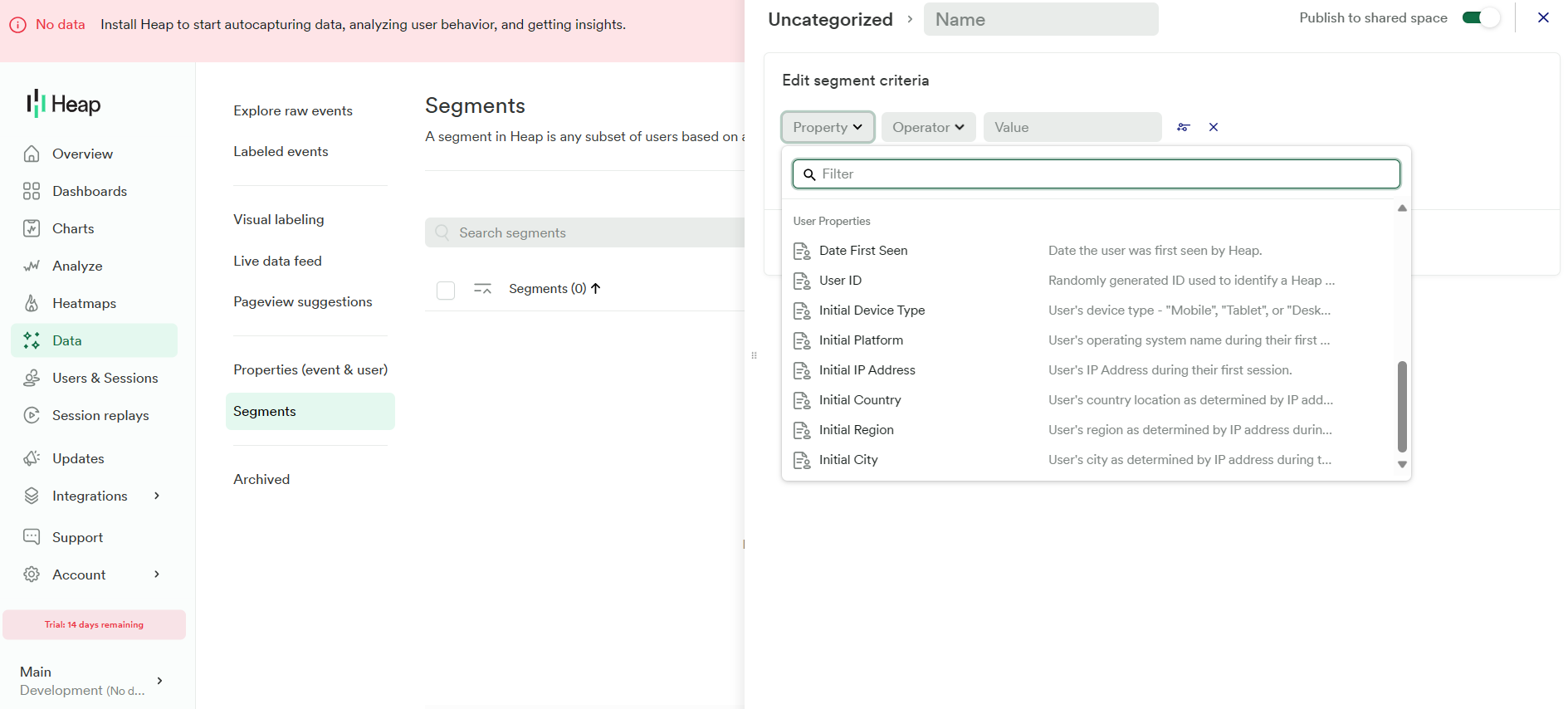
Here’s how you can do that:
- Head to the Data section in your Heap dashboard and select Segments. Any user segments you’ve defined earlier will be available here.
- Click Define Segment to create a new user group. You can segment users based on their actions, behavior, and properties (demographics, devices, etc.). Make sure you add a relevant label to each segment.
- Once you’ve created a segment, you can use it to filter all kinds of data, including Funnel, Engagement, and Retention analysis.
It’s worth noting that Heaps offers limited segmentation criteria. If you’re looking to segment users based on more detailed parameters, such as feedback and interaction with tagged features, Userpilot would be a better fit.
Heap’s behavioral analytics
Monitoring user behavior can be instrumental in helping you understand how users interact with different elements and features. Also, it offers insight into various paths users take to navigate your product. That, in turn, can help you identify users who repeat an action, reach a goal, or churn.
Heap facilitates user behavior analysis with the following tools:
- The Autocapture feature tracks user actions and collects event data as soon as you install Heap into your product. You need not set up custom events. That means you can monitor user behavior retroactively.
- Session Replays and Heatmaps provide you with an in-depth overview of how users navigate your product, including the actions they take and the roadblocks they face.
- With the Usage over time chart, you can monitor how different user segments interact with your product and even compare the behavior of different segments.
Heap’s user journey mapping
User journey mapping is effective in helping you understand user interactions with your product from start to finish. It’s a visualization method that provides actionable insights to improve user experience.
In Heap, you can use Journeys for user journey mapping. You can either build a user or account analysis with this feature.
Building a Journey chart starts with you deciding whether you want to examine all the paths that start or lead to a specific event. Then you can either input the addition steps or just click Show common paths to view results.
In case you add your own steps and branches, you can also click on the steps to view alternative paths that users take. However, there’s no option to view only the top common paths if you prefer a more granular view.
Morever, there have been reports of issues with collecting events in Heap. If you decide to import your event data rather than relying on auto-collected data from Heap, your custom API events must be meticulously structured at a top level to ensure proper reading. Or else, Heap may misinterpret your events, leading to data inaccuracies. Plus, Heap Events have a complex structure, with properties scattered across event, user, and property levels. This makes it challenging for you to locate the needed properties without specific knowledge.
Heap’s cohort analysis
Cohort analysis is indispensable for improving customer retention and minimizing churn. It involves dividing users into different cohorts based on shared attributes and behaviors and analyzing their usage patterns.
Here’s how you can use Heap to perform cohort analysis:
- Heap lets you segment users based on their actions, behavior, and demographic properties. For instance, you can segment users based on their location, IP address, or whether they complete a specific action.
- You can also create groups for users who repeat certain events or re-engage with your product. It can help you create user groups like promoters and detractors. These are the kinds of segments that work best for cohort analysis.
- Once you’ve created these segments, you can use Retention charts under Analyze to compare retention rates for different cohorts.
- Similarly, you can use the Funnel chart to compare conversion rates for different cohorts and understand user behaviors/properties that lead to desired outcomes.
What are the pros and cons of Heap?
Heap’s pros
As a cutting-edge digital insights platform, Heap offers several valuable features for product developers, marketers, and customer success teams. Let’s take a closer look at its benefits.
- Automated data capture – Heap’s Autocapture feature lets you automatically track user actions, such as clicks, swipes, page views, and form submissions. That means you don’t have to worry about setting up custom tracking for each event. Also, you can track events retroactively.
- Easy setup – Getting started with Heap is as easy as installing a code snippet into your product. In other words, you don’t need a lot of technical knowledge or expertise.
- Advanced analytics – Besides Autocapture, Heap also lets you track custom events and services-side events to help you build a comprehensive user behavior data set. With features like Heatmaps and Session Replays, it results in unparalleled insights into how users navigate your product and the paths that lead to desired outcomes.
- Real-time insights – With the Live data feed, you get a chronological and real time view of all Heap events (raw and labeled). That means you can track and analyze user interactions as they happen.
- Seamless collaboration – Features like Shared Spaces facilitate collaboration and reporting among cross-functional teams. Similarly, you can share Session Replays with other team members.
- Web and mobile support – Heap works on all kinds of products, be it websites, web applications, or mobile apps.
- Extensive integrations – Heap supports integrations with more than 100 platforms, including customer engagement tools, data warehouses, product adoption tools, etc.
- Emphasis on customer education – Heap provides a variety of helpful resources to get you get started with the platform and use it to the fullest. These include Heap University (video tutorials), Heap Plays (how-to guides), Help Center, and a comprehensive blog and content library.
Heap’s cons
Heap comes with an impressive set of features that provide you with a 360-degree view of how users navigate your product and interact with various elements. But the product analytics platform isn’t without limitations.
Here are a few drawbacks of Heap worth mentioning:
- Steep learning curve – While the setup is a cakewalk, Heap involves a fairly steep learning curve due to its vast array of features. As a new user, it’ll take you a while to get a grip on all its features.
- Data storage requirements – Heap’s Autocapture feature requires you to collect and store a ton of data. Things can get expensive quickly as your product attracts new users.
- Lack of an engagement layer – While Heap offers an in-depth overview of user behavior and product usage, it doesn’t let you act on these insights. You’ll need other customer engagement tools to trigger targeted in-app experiences based on data and insights from Heap.
- Limited segmentation capabilities – Heap lets you segment users based on events and properties. It can be restrictive when you want to build hyper-personalized user journeys.
What do users say about Heap?
Heap boasts a rating of 4.3 (out of 5 stars) on G2 and 4.5 (out of 5 stars) on Capterra. Most users praise the platform’s advanced data capture and analytics capabilities and the intuitive UI.
Here’s what a Heap user has to say:
“Retroactive conversion rate and funnel data without tag manager”
We’ve been using Google Analytics for years but have time and time again found ourselves limited to reporting on what we had the foresight to create tags for. Heap doesn’t make us regret not having thought ahead and instead, we feel rewarded with historical data and benchmarks for conversion and click rates for anything we can think of.
Some of the reports appear to be very similar in what they are showing us, but that is also a positive in that we have the flexibility to arrive at insights via a number of paths.
Heap helps us determine what elements on our website have a positive impact on our SaaS lead gen website’s conversion rates and which produce bottlenecks and confusion.
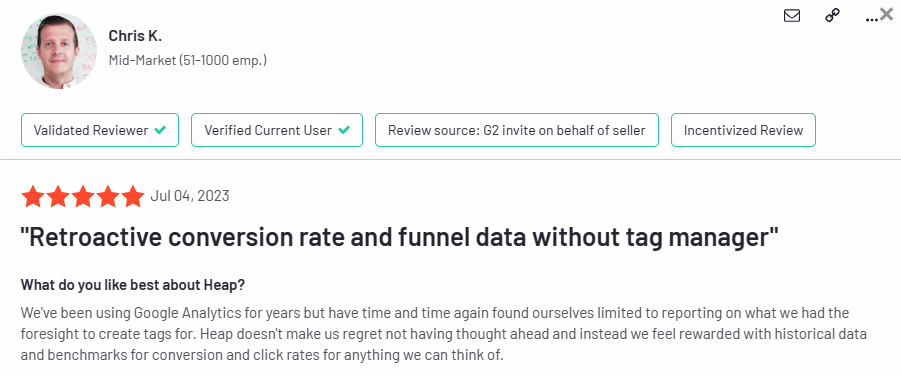
-
- Despite generally stellar ratings and reviews, some Heap users complain about the overwhelming learning curve and lack of thorough onboarding.
Here’s what a user has to say about Heap:
“6 months into Heap, has not drove value for product analytics team yet”
Auto capture and snapshotting are very cool in theory, but they don’t work all the time. The implementation was not done perfectly in onboarding, so tagging roadblocks and limitations constantly come up.
Extremely challenging to natively tag a complex site with microsites, clients, etc. involved in the product funnel. iOS and Android app tagging are not straightforward, and most end users of Heap can’t figure out how to do it, even with documentation and video instruction. Segment integration doesn’t work seamlessly. The lack of support from Heap reps (specifically in the form of workshops, examples using our data, walk-throughs, q&a has been pretty terrible. We had one session right when onboarding to walk us through the tool, but nothing since.
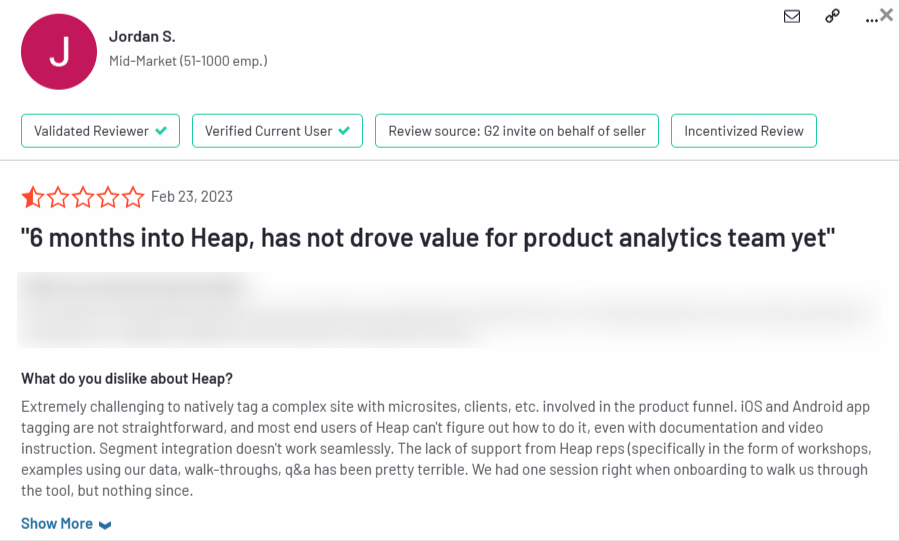
Heap’s pricing
Pricing for Heap is available on request. You’ll have to contact the sales team for a quote. The final price will depend on various factors, including the number of sessions and integrations you need.
That said, Heap offers a free plan that lets you track up to 10,000 user sessions per month and stores your data for 6 months. Review platforms like G2 say that paid plans start at $3,600 per year. All paid plans come with a 14-day free trial, too.
You can choose from the following plans:
- Free – Ideal for teams looking to establish product-market fit.
- Starter – Suitable for startups looking to scale their business.
- Growth – Useful for companies that need advanced features, such as account analytics and report alerts.
- Pro – Tailored for enterprise businesses with robust security and compliance requirements.
It’s worth mentioning here that Heap offers a handy ROI calculator to help you get a clearer picture of whether it’s worth the investment.
3 Reasons why you might need a Heap alternative
Heap is one of the most sophisticated product analytics tools available in the market. But it isn’t without flaws.
Here are three scenarios where it makes sense to look for a Heap alternative:
- Your team lacks technical know-how – While it’s easy to install and configure Heap, navigating its features requires a bit of technical expertise. If your team members come from non-technical backgrounds, they might struggle to use Heap to the fullest.
- You want to trigger in-app experiences based on analytics – Heap doesn’t offer built-in tools to personalize the user experience based on product analytics and insights. You’ll need to use third-party engagement tools to turn these insights into actions. A product adoption platform like Userpilot can help you bypass the process of finding the right engagement tools.
- You’re on a budget – You need to set up a robust data storage infrastructure to retain all the data and insights collected from Heap. This is in addition to the monthly or annual subscription fee you’ll pay to use Heap. As a result, you’ll likely end up overshooting your budget, which makes Heap unsuitable for small teams and early-stage startups.
Userpilot – A better alternative for churn analytics

Here are the Userpilot features you can use to track and interpret churn analytics:
- Funnel Reports: Userpilot’s funnel reports help you track and visualize the drop-off in user activity between each stage. This can show you where most users get stuck and highlight friction points that may be leading to customer churn so you can repair the leak.
- Path Reports: Userpilot helps you conduct path analysis without coding. With Paths, you have a detailed understanding of customer actions through a sequence of steps, and helps pinpoint areas where customers tend to drop off – an indication of churn.
- In-App Surveys: Userpilot survey templates help you gather satisfaction metrics like NPS, CSAT, and CES data that can predict churn. You can also use Userpilot to build an in-app churn survey that asks users why they’re leaving and offers them alternatives to canceling their subscriptions.
- NPS Dashboard: The dedicated Net Promoter Score dashboard compiles response data from all your NPS surveys, calculates response rates, and shows you how the score has been trending over time so you can sort through qualitative responses to find the root cause(s) behind churn.
- Cohort analysis: Analyze retention trends using cohort tables. This functionality will be available in Q4 of 2023.
Userpilot’s user segmentation analysis
User segmentation is a key part of building a contextual onboarding experience for new customers. Userpilot lets you segment your customers when they meet specific conditions, filter through analytics using user attributes, and trigger flows for users in different segments.
Here are some of Userpilot’s customer segmentation capabilities:
- Conditional Segments: Userpilot lets you build segments for users who match conditions on what device/browser/OS they’re using, which country they live in, what their NPS score is, and any custom events they’ve performed. You can then use these segments as filters/triggers.
Userpilot’s behavioral analytics
Behavioral analytics make it possible to monitor user activity, group data into cohorts, and extract relevant metrics/insights. Userpilot lets you tag features to see how users interact with them, compare goals by cohort, and create trend reports that track behavioral patterns over time.
Here are some Userpilot features you can use for user behavior tracking:
- No-Code Feature Tagging: Userpilot’s click-to-track feature tagger lets you mark features, buttons, and elements with the Chrome extension. You’ll be able to track user interactions such as clicks, hovers, or inputs to get an accurate behavioral view for specific features.
- Trends Reports: Generating trends reports will help you visualize the occurrence of key events over time and break down these analytics by device, browser, operating system, country, signup date, or even individual user IDs and email addresses to see granular behavioral analytics.
- Path Reports: Path analysis is useful for understanding common user behavior patterns, gauging user interactions with UI, monitoring if users follow recommended workflows, and identifying points of drop-offs and areas for improvement. With collected events, you can easily set up Path analysis in Userpilot without coding.
Userpilot’s user journey mapping
User journey mapping helps you visualize all the interactions between users and your product as they try to achieve a particular goal. Userpilot’s detailed user analytics and funnel/trend reports help you track customers as they progress through different stages of their journey.
Here are the Userpilot features you can use for user journey mapping:
- User analytics: The Users dashboard provides detailed analytics of your entire customer base. You’ll be able to sort by segment, company, or time period and add multiple filters to help you narrow results. You can also perform bulk actions and export user data in a CSV format.
- Funnel reports: These reports help you visualize the user journey map by showing which stage, page, or action most users get stuck on. You’ll also be able to view breakdowns so you can see how the user journey changes depending on which OS, browser, or device type a user is on.
- Trend reports: Userpilot’s trend reports offer behavioral insights such as how often users perform a specific action, the number of unique users who take that action, and where in the user journey these actions occur. You can also create custom metrics and build your own charts.
- Path reports: You can generate and access path reports directly within the reporting builder in Userpilot, alongside funnels, trends, and retention reports. With Paths, you have a better understanding of user flows and journeys – how customers interact with your products, navigate the features, etc.
Userpilot’s cohort analysis
User retention is critical for the success of digital products, it’s linked to the product’s ability to consistently deliver value to the users and is a key measure of business health. It is also essential in the process of achieving a product-market fit and retaining constant growth.
For starters, Userpilot allows you to collect accurate data on user behavior inside web apps without any coding.
Thanks to its Chrome extension, you can easily tag features and create custom events to track with a few clicks.
Once you have the data, you can use it to build the cohort analysis table.
Userpilot allows you to:
- Create cohorts on the user and company level.
- Choose the start and return events defining retention in your product, like ‘Signed in’ and ‘Invited teammate’.
- Filter the events by events, user, and company properties.
- Choose the interval by which you view the data (days, weeks, months) and date range (e.g. last 2 weeks, or last 180 days).
Clicking on each cell reveals data on specific users that were retained.
You can also visualize the average retention as a line graph, both linear and cumulative.
Cool isn’t it?
It gets even better!
You can enhance the insights from cohort analysis by pairing it up with other analytics features:
- Funnel analysis – to visualize user conversions and drop-offs at key stages in the journey.
- Trends analysis – to track key metrics over time.
- Paths – to visualize all the events leading up to or following a conversion.
What are the pros and cons of Userpilot?
Userpilot pros
As a full-suite digital adoption platform, Userpilot has all the features you need to onboard users, track analytics, and gather feedback from customers without writing a single line of code. Here are a few pros of using Userpilot as your product growth solution:
- No-code builder: Userpilot’s Chrome extension lets you build flows, add UI elements, and tag features without writing a single line of code.
- UI patterns: There are plenty of UI patterns to choose from when using Userpilot, such as hotspots, tooltips, banners, slideouts, modals, and more!
- Startup-friendly: Userpilot’s entry-level plan gives you access to all available UI patterns so you can hit the ground running.
- Walkthroughs and flows: Build engaging interactive walkthroughs and personalized onboarding flows that target specific segments of your user base.
- Self-service support: Build an in-app resource center to help users solve problems, customize its appearance to align it with your brand, and insert various types of content (videos, flows, or chatbots) to keep your customers satisfied.
- A/B testing: Userpilot’s built-in A/B testing capabilities will help you split-test flows, iterate on the best-performing variants, and continually optimize based on user behavior.
- Feedback collection: Userpilot has built-in NPS surveys with its own unified analytics dashboard and response tagging to help you retarget users. There are other survey types to choose from and you can even create your own custom survey.
- Survey templates: There are 14 survey templates to choose from so you can gather feedback on specific features or run customer satisfaction benchmarking surveys like CSAT and CES.
- Advanced analytics: Userpilot lets you analyze product usage data, monitor engagement on all in-app flows, and use the data to create user segments that are based on behaviors instead of demographics.
- Event tracking: Userpilot’s no-code event tracking lets you tag UI interactions (hovers, clicks, or form fills) and group them into a custom event that reflects feature usage.
- Third-party integrations: Userpilot has built-in integrations with tools like Amplitude, Mixpanel, Kissmetrics, Segment, Heap, HubSpot, Intercom, Google Analytics, and Google Tag Manager so you can share data between all the solutions in your tech stack.
Userpilot’s cons
Of course, no tool is perfect and there are a few cons to consider before choosing Userpilot as your user onboarding or product growth solution:
- Employee onboarding: Currently, Userpilot only supports in-app customer onboarding.
- Mobile apps: Userpilot doesn’t have any mobile compatibility which could make it difficult for developers with cross-platform applications to create a consistent user experience for both versions of their product.
- Freemium plan: There’s no freemium Userpilot plan so those bootstrapping their startup and need sub-$100 solutions should consider more affordable onboarding platforms like UserGuiding or Product Fruits.
What do users say about Userpilot?
Most users laud Userpilot for its versatile feature set, ease of use, and responsive support team:
I recently had the pleasure of using Userpilot, and I must say it exceeded all my expectations. As a product manager, I’m always on the lookout for tools that can enhance user onboarding and improve overall user experience. Userpilot not only delivered on these fronts but also went above and beyond with its impressive new features, unparalleled ease of use, and truly exceptional customer support.
What truly sets Userpilot apart is its outstanding customer support. Throughout my journey with Userpilot, the support team has been responsive, knowledgeable, and genuinely dedicated to helping me succeed. Whenever I had a question or encountered an issue, their support team was always there to assist promptly, going above and beyond to ensure my concerns were addressed effectively.
Source: G2.
Of course, other users are also kind enough to share constructive criticism regarding specific features like event tracking filters:
“The filtration while analyzing specific events is a little confusing. Understanding of custom properties and data management configuration could have been more organised.”
Source: G2.
Userpilot’s pricing
Userpilot offers flexible pricing based on your monthly active users (MAUs). Plans start at $299 per month for smaller teams and scale as your user base grows.
Below are the pricing tiers you can choose from:
- The Starter plan begins at $299/month (billed annually) for up to 2,000 monthly active users. It includes in-app user engagement, usage trend analysis, NPS surveys, and essential product analytics—ideal for mid-market SaaS teams getting started.
- The Growth plan offers custom pricing and adds advanced analytics, retroactive event auto-capture, in-app surveys, session replay, and more. It’s the most popular choice for growing teams that need deeper insights and scale.
- The Enterprise plan offers custom pricing and includes everything in Growth, plus bulk data handling, custom roles and permissions, SOC 2 Type 2 compliance, and enterprise-level support.

Conclusion
There you have it.
It should be easier now to make an informed decision whether Heap is your go-to option for churn analytics. Ultimately, the best choice will depend on your product and current needs.
If you’re looking for a better alternative to Heap for churn analytics, book a Userpilot demo today to experience firsthand how it can enhance your user experience and drive product growth!

